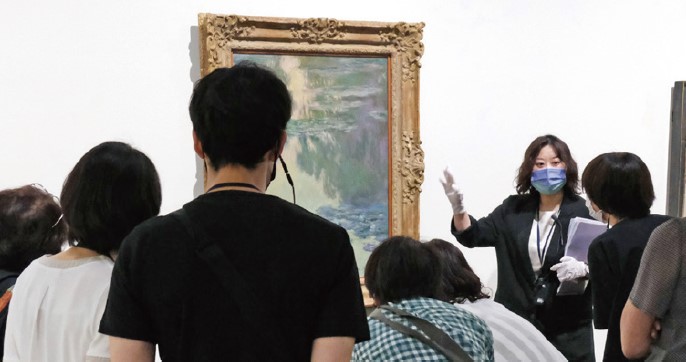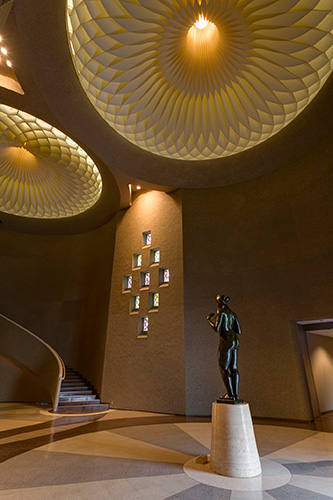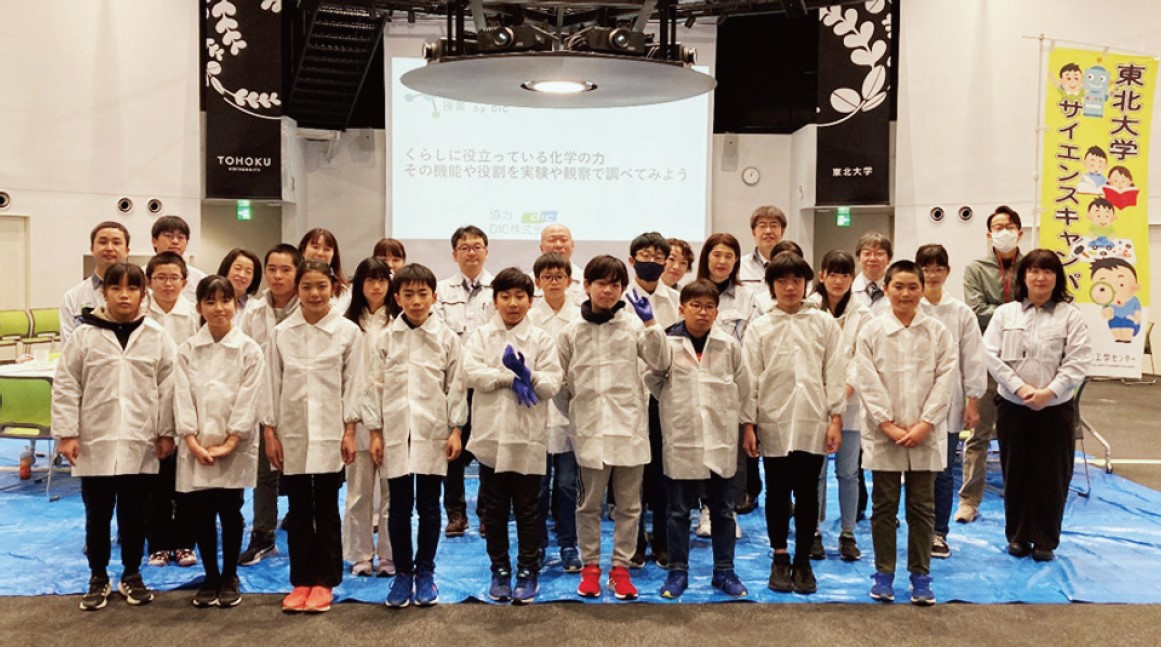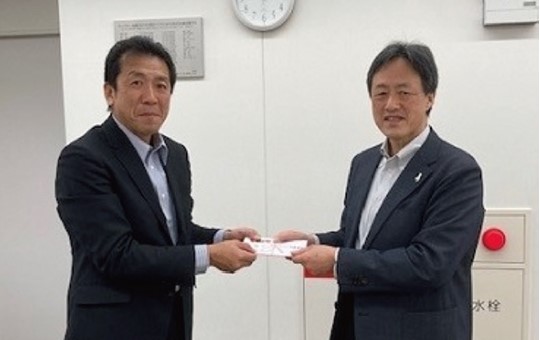Social Contribution Activities
- Basic Approach to Social Contribution
- Guidelines for Social Contribution Activities
- CUD: The Future of Color and Comfort
- Kawamura Memorial DIC Museum of Art
- Visiting Science Lab Program
- Initiatives Led by the Central Research Laboratories
- Initiatives Led by the Kashima Plant
- Initiatives at DIC Group Companies in Other Countries and Territories
- Matching Gift Program
Basic Approach to Social Contribution
Based on its Guidelines for Social Contribution Activities, established in fiscal year 2009, the DIC Group works to ensure harmony with local communities and individuals through activities aimed at building a strong relationship with society.
Guidelines for Social Contribution Activities
In line with its vision statement, “We improve the human condition by safely delivering color and comfort for sustainable prosperity—Color & Comfort,” the DIC Group will promote social contribution in three areas: Business activities, culture and education, and communities and society.
Business activities
The DIC Group will offer products and services that contribute to the development of a sustainable society and protection of the global environment from the perspective of “sustainability through business activities.”
Culture and education
The DIC Group will engage in initiatives that will contribute to the development and promotion of culture, the arts, science and education, including fostering next-generation human resources in areas such as the culture of color and chemistry.
Communities and society
The DIC Group will strive to coexist harmoniously with local communities to develop a relationship of mutual trust. Moreover, the Group will provide an environment that enables employees to engage in voluntary initiatives in their respective local communities.
Principal Initiatives
CUD: The Future of Color and Comfort
Guided by its vision statement, the DIC Group is actively involved in R&D in the area of color universal design (CUD), helping to bring color to life through efforts in a variety of fields.
・Initiatives in Fiscal Year 2023
DIC began providing the brand logo and user manual for Lucida® tactile paving blocks—which combine high visibility for visually impaired individuals and is in harmony with the environment—free of charge to tactile paving manufacturers. This allows the use of Lucida® blocks together with blocks sold by other manufacturers made from different materials, including ceramic tile, resin and concrete, by ensuring the same color. In addition to ensuring the visibility and recognizability of tactile paving, this helps secure aesthetic coherence for areas where this paving is installed.
The Lucida® logo was developed by DIC Group company DIC Color Design, Inc. The tail on the “u” evokes the enhanced walkability made possible by tactile paving. Going forward, DIC will continue working to advance the creation of social infrastructure that incorporates CUD.
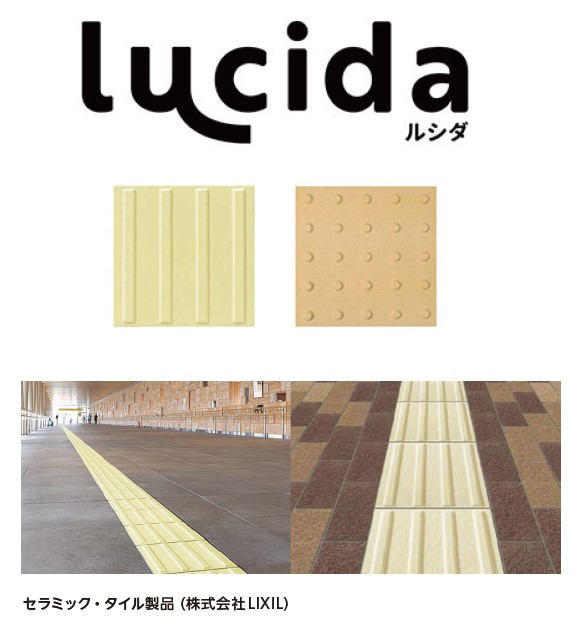
• 2007–2010
Under the supervision of the University of Tokyo, the DIC Group worked with the Japan Paint Manufacturers Association, the Industrial Research Institute of Ishikawa and the Color Universal Design Organization, an NPO, to create the Color Universal Design–Recommended Color Set.
• 2011–2014
The DIC Group and architect Kengo Kuma collaborated to develop new tactile pavement that ensures high visibility for visually impaired individuals and is in harmony with the landscape. Subsequently, in spring 2018, two new colors—a warm orangey yellow and a cool yellowish green—were commercialized under the name Lucida®.
• 2015–2017
The DIC Group participated in a joint industry–academic research project, as part of which Chiba University, the Central Research Laboratories and DIC Color Design gave presentations at academic conferences around the world on research regarding the color appearance of red spot colors used for printed warnings and other information on packaging and on the use of color in printed materials to enhance readability for seniors.
• 2018
Taking into account nearly a decade in use, the Color Universal Design–Recommended Color Set’s color values were revised and a guidebook was published to further enhance the set’s usability. In addition, the Japan Industrial Standards (JIS) announced new safety colors that can be distinguished by people with diverse types of color vision (JIS Z 9103). As a member of the original drafting committee, the DIC Group was involved in setting recommended CMYK values for process printing and collaborated in subsequent activities aimed at advancing awareness.
• 2019–2021
The DIC Group collaborated in the verification of color schemes for disaster applications including prevention-related information. This included taking part in verification testing for screen displays for a color scheme (five colors) developed to convey heavy rain warning levels in an easy-tounderstand manner, which was announced in 2020 by Japan’s Cabinet Office. In formulating CMYK values for this color scheme, announced in 2021, DIC Graphics cooperated by not only verifying candidate colors but also printing a color chart for use in the verification process.
• 2022
The DIC Group published a feature article on its efforts to contribute to society through the provision of color in the Japanese-language space of its global website. Since then, the Group has worked to provide stakeholders with information on its initiatives to make society more accessible to people with diverse types of color vision, as well as to introduce key difference makers from both within and outside the Group.
Kawamura Memorial DIC Museum of Art
DIC operates the Kawamura Memorial DIC Museum of Art as a social
contribution initiative particularly suited to an organization involved in
the provision of color. Established in 1990 to publicly exhibit works of art
collected by DIC Corporation and its affiliates, the museum is located
adjacent to the Central Research Laboratories in Sakura, Chiba Prefecture
and boasts an extensive collection spanning numerous genres that
includes an oil portrait by Rembrandt, a rarity in Japan, as well as works by
impressionists such as Monet and Renoir; modern European artists such
as Picasso and Chagall; early modern, modern and postwar Japanese
artists; and luminaries of late-20th century American art, including Mark
Rothko, Frank Stella and Joseph Cornell. In addition to a standing exhibit,
the museum stages special exhibitions multiple times a year to encourage a
deeper understanding of the works in its collection.
Another appealing aspect of the museum is its lushly forested 10-hectare site, alive with seasonal flowers and foliage, which has been open to the public since the facility’s establishment. A total of 250 cherry trees—10 varieties in total—blossom every spring, while in summer wildflowers of all colors bloom profusely.
In fiscal year 2024, the museum celebrates its 35th anniversary. Two special exhibitions are being held. “Carl Andre: Between Sculpture and Poetry,” which ran from March 9 through June 30, 2024, was the first solo exhibition at a Japanese museum to fully introduce the works of Carl Andre, one of the best-known sculptors of the Minimal Art movement, which emerged in the United States in the late 1960s. “Katsuhito Nishikawa: Serenity in Stillness,” scheduled to be held from September 14, 2024 through January 26, 2025, will feature approximately 60 works, including sculptures, photographs, paintings, drawings and installations, by Japanese artist Katsuhito Nishikawa, who has been based in Germany since the 1980s.
Many museum programs, including regularly scheduled guided tours and educational tours, have returned to pre-pandemic levels. The “mite!” (“look!”) interactive art-viewing experience, which moved online during the COVID-19 years, was once again also held on-site in the museum’s galleries, allowing participants to take advantage of both formats.
Looking ahead, the museum will continue to promote site environmental initiatives, plan and stage exhibitions centered around works from its collection, and advance social contribution activities with a view to encouraging communication with the community.
Related Link
Visiting Science Lab Program
In line with the Japanese government’s efforts to further career education initiatives, DIC conducts visiting science labs at public elementary schools. Since the launch of this program in 2010, DIC has provided labs for approximately 3,350 students at 47 facilities (elementary schools and university facilities, the latter as part of an event).
In fiscal year 2023, the Company participated in Tohoku University’s Science Campus project with a lab for 38 participants, primarily fifth- and sixth-year students. Based on the theme of “Color & Comfort,” the lab highlighted how science can help secure a brighter future for humanity and the planet, and comprised experiments that involved observing the mechanism of color printing, extracting natural pigments from algae and dissolving recyclable adhesives. The program was well received by participating students, who commented on the interesting nature of the experiments and the joy of making new discoveries, and studiously took notes. Going forward, the DIC Group will continue to promote this and other “Color & Comfort”-themed programs that make science fun for children and which spark enthusiasm for chemistry.
Initiatives Led by the Central Research Laboratories
The Central Research Laboratories provides support for education through a variety of initiatives. These include assisting with the Annual Meeting on Scientific Research by High Schools, which is sponsored by Chiba University’s Section of Collaboration with High Schools.
The Central Research Laboratories also advances efforts that leverage DIC’s unique capabilities. These include lectures for high schools that have earned Super Science High School* designation, including Seishin Gakuen High School in Ibaraki Prefecture, and Sakura Senior High School and Funabashi High School in Chiba Prefecture, as well as fashion design workshops for students from Sakura Higashi High School in Chiba Prefecture.
In addition, in an initiative aimed at assisting with regional revitalization efforts, the Central Research Laboratories has cooperated with the Sakura Film Commission since 2022 at the request of the Sakura City government. This includes allowing use of its site as a filming location and providing support in various forms for dramas, movies and other productions.
- “Super Science High School” is a designation awarded by Japan’s Ministry of Education, Culture, Sports, Science and Technology to high schools that implement curricula focused on the sciences and mathematics that goes beyond the Ministry’s official guidelines with the aim of fostering the next generation of talented engineers and scientists.
Highlights of Fiscal Year 2023
- Five researchers from the Central Research Laboratories attended the Annual Meeting on Scientific Research by High Schools, listening to a total of 305 research presentations by high school students from across Japan, taking part in Q&A sessions and otherwise encouraging research by participating students who aspire to careers in technical fields.
- Educational support activities included holding color design lectures at Sakura Higashi High School and Seishin Gakuen High School. The Central Research Laboratories also continues to assist Super Science High School–designated institutions through participation by executive-level employees in the steering committees of Sakura Senior High School and Funabashi High School, where they provided advice from a corporate perspective.
- The Central Research Laboratories also promoted initiatives timed to coincide with schools’ summer vacations that sought to nurture children’s interest in science and technology, as well as in working in the manufacturing sector. These included hosting the Chiba Prefectural Dream Challenge Hands-On School, a popular program for elementary school children organized by the prefecture’s Board of Education, and participating in the “Now I Get It! Technologies of the Future” exhibition.
Initiatives Led by the Kashima Plant
The Kashima Plant, in Ibaraki Prefecture, has accepted trainees in cooperation with Ibaraki Hasaki High School’s internship program—dubbed the Hako Dual System—since 2008. In fiscal year 2023, two students from the school’s industrial chemistry and information sciences programs participated in lectures on product knowledge and safety, and in practical training at the plant, from October through November. Additionally, in collaboration with the Kamisu City Community Medicine Promotion Section, the plant made itself available for on-site training for interns participating in the fiscal year 2023 Occupational Health Fundamentals Workshop with the aim of helping improve the skills of occupational physicians by enhancing interns’ understanding of production facilities.
Initiatives at DIC Group Companies in Other Countries and Territories
P.T. Pardic Jaya Chemicals Invites University Students to Visit the Company
DIC Group company P.T. Pardic Jaya Chemicals, in Indonesia, invited university students to visit the company. Approximately 30 students participated in the visit, which included a production facility tour, to learn about the company’s business and its production activities.
Donations Provided for Turkey–Syria Earthquake Relief
DIC donated ¥10 million via the Japanese Red Cross Society to provide support for all those affected by the major earthquake that struck Turkey and Syria in February 2023, as well as to help with reconstruction. Group company Sun Chemical also provided support to the disasterstricken areas.
Matching Gift Program
DIC has a matching gift program whereby it matches the total amount collected through an annual year-end fundraising drive spearheaded by its employees’ union. Funds raised through the 2023 drive and matching gift program were donated to 20 recipients, including facilities providing social welfare services and those providing support for disabled individuals.
Back number


